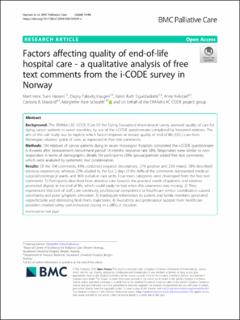| dc.contributor.author | Hansen, Marit Irene Tuen | |
| dc.contributor.author | Haugen, Dagny Faksvåg | |
| dc.contributor.author | Sigurdardottir, Katrin Rut | |
| dc.contributor.author | Kvikstad, Anne | |
| dc.contributor.author | Mayland, Catriona Rachel | |
| dc.contributor.author | Schaufel, Margrethe Aase | |
| dc.date.accessioned | 2021-04-12T10:45:17Z | |
| dc.date.available | 2021-04-12T10:45:17Z | |
| dc.date.created | 2020-07-17T13:33:12Z | |
| dc.date.issued | 2020 | |
| dc.identifier.issn | 1472-684X | |
| dc.identifier.uri | https://hdl.handle.net/11250/2737288 | |
| dc.description.abstract | Background
The ERANet-LAC CODE (Care Of the Dying Evaluation) international survey assessed quality of care for dying cancer patients in seven countries, by use of the i-CODE questionnaire completed by bereaved relatives. The aim of this sub study was to explore which factors improve or reduce quality of end-of-life (EOL) care from Norwegian relatives’ point of view, as expressed in free text comments.
Methods
194 relatives of cancer patients dying in seven Norwegian hospitals completed the i-CODE questionnaire 6–8 weeks after bereavement; recruitment period 14 months; response rate 58%. Responders were similar to non-responders in terms of demographic details.104 participants (58% spouse/partner) added free text comments, which were analyzed by systematic text condensation.
Results
Of the 104 comments, 45% contained negative descriptions, 27% positive and 23% mixed. 78% described previous experiences, whereas 22% alluded to the last 2 days of life. 64% of the comments represented medical/surgical/oncological wards and 36% palliative care units. Four main categories were developed from the free text comments: 1) Participants described how attentive care towards the practical needs of patients and relatives promoted dignity at the end of life, which could easily be lost when this awareness was missing. 2) They experienced that lack of staff, care continuity, professional competence or healthcare service coordination caused uncertainty and poor symptom alleviation. 3) Inadequate information to patient and family members generated unpredictable and distressing final illness trajectories. 4) Availability and professional support from healthcare providers created safety and enhanced coping in a difficult situation.
Conclusions
Our findings suggest that hospitals caring for cancer patients at the end of life and their relatives, should systematically identify and attend to practical needs, as well as address important organizational issues. Education of staff members ought to emphasize how professional conduct and communication fundamentally affect patient care and relatives’ coping. | en_US |
| dc.language.iso | eng | en_US |
| dc.publisher | BMC | en_US |
| dc.rights | Navngivelse 4.0 Internasjonal | * |
| dc.rights.uri | http://creativecommons.org/licenses/by/4.0/deed.no | * |
| dc.title | Factors affecting quality of end-of-life hospital care - a qualitative analysis of free text comments from the i-CODE survey in Norway | en_US |
| dc.type | Journal article | en_US |
| dc.type | Peer reviewed | en_US |
| dc.description.version | publishedVersion | en_US |
| dc.rights.holder | Copyright The Author(s). 2020 | en_US |
| dc.source.articlenumber | 98 | en_US |
| cristin.ispublished | true | |
| cristin.fulltext | original | |
| cristin.qualitycode | 1 | |
| dc.identifier.doi | 10.1186/s12904-020-00609-x. | |
| dc.identifier.cristin | 1819720 | |
| dc.source.journal | BMC Palliative Care | en_US |
| dc.identifier.citation | BMC Palliative Care. 2020, 19, 98. | en_US |
| dc.source.volume | 19 | en_US |

